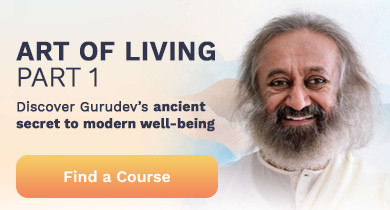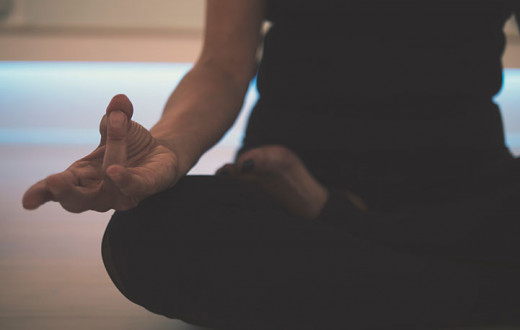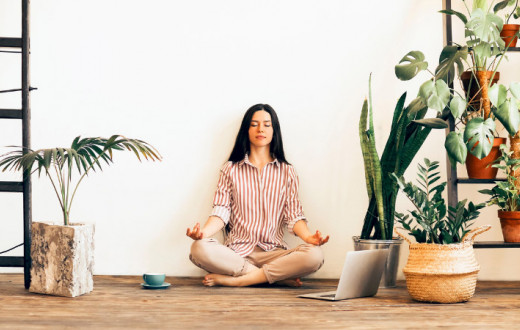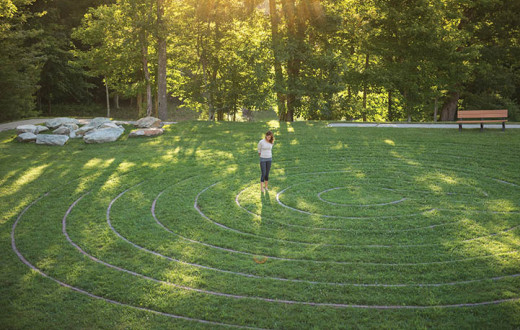By Elizabeth Herman | Posted : September 23, 2020
James Nestor, in his new book “Breath: The New Science of a Lost Art,” states "by the law of averages, you’ll take 670 million breaths in your lifetime." But other than the number of breaths you take, you’d be astounded at the amount of power breathing has over your life.
Have you noticed that your mind doesn't obey when you tell it what to do? Try to stop thinking about something, such as an elephant in the room, or a stain on your co-worker's shirt. As soon as you issue commands, your mind does its own thing.
However, your feeling and thinking does follow how you breathe in specific rhythms. For inner peace, a rhythmic breathing pattern brings about awareness and joy. Keeping your attention on your breath, also known as mindful breathing, can help you focus on the present moment.
Founder of Art of Living, Gurudev Sri Sri Ravi Shankar says, “The rhythm of the breath changes with different emotions; it's different when there's fear, anger. According to the level of stress in us, there's a breathing rhythm that changes.”
Not only does our emotional state change breath, but our breathing rhythm changes emotions. Since breath is an involuntary function we can also control, we can regulate our emotions using the specific rhythms of breath.
When 4 experts first started breath meditation
To illustrate how the breath can influence the mind and emotions, we sat down with several senior teachers of the Art of Living SKY Breath Meditation technique (also known as Sudarshan Kriya). We talked about their experiences with breathing meditation, the various breathing techniques offered in Art of Living courses, and the many benefits of regular practice. They also shared recommendations and advice for the journey to stress free living.
All of the teachers recalled profound experiences when they tried breath meditation. For instance, Scott Hague, a senior teacher at Art of Living Retreat Center in Boone, North Carolina, said, “I’ve been meditating since I was 14 and love it. But once I learned pranayama and especially the SKY Breath I found tools to bring me to the perfect start of meditation. Even on a stressful day I can sit, do my breathing, feel centered, and the breath releases stress. Then, meditation starts from being still and goes to a very deep place.”
Other teachers also spoke of how still and calm they felt. “The first time,” said Ajay Tejasvi, a meditation expert from Washington DC, “when I had done the Art Excel course, and when I completed the 10th grade, I got all my classmates to join and we all learned breathing meditation. It was a very special experience and gave me a deep experience of stillness, a sense of confidence, and clarity of thought, something you wouldn’t associate with teenagers. It opened up so many more dimensions.”
“When I was learning the SKY Breath, the bottom went out of my meditation,” said Pam Brockman, meditation teacher from Chicago, who has been practicing and teaching meditation for more than 30 years. “Sudarshan Kriya relieved so much more emotional and physical stress. So my meditations got much more satisfying.”
Another teacher who had meditated before learning SKY, Joan Goodrum from the West Coast, said, “My meditations were deep and peaceful, but I was asthmatic and never had enough energy. Gradually I incorporated breathing techniques daily. After several years, I no longer had asthma attacks! I had learned to breathe correctly. This changed my entire physiology. Along with this, gradually I began having much more energy.”
Benefits of breath meditation
What are specific ways breath meditation can benefit you? Our experts weighed in on this crucial question.
“All of these practices from the SKY Breath Meditation workshop,” said Ajay, “have an impact on your brain’s alpha waves and beta waves. Alpha activity is responsible for relaxation, and beta activity creates alertness. Studies found both alpha and beta activity as sustained and elevated during practice, pointing to relaxed alertness, a very unique state. Generally, when you’re alert you’re tensed up. If you can focus and relax at the same time, that’s a beautiful state of mind!”
Pam described how “It decreases depression and anxiety. It increases energy and resilience to stress and future stresses. One study among combat veterans indicated that stress leaves the system long term. Symptoms were dramatically reduced and their stress levels, when tested after one year, remained lower, at the same or a lower rate.”
In addition, she recounted how “Usually at the end of a (SKY Breath Meditation) course, people hug and even if they’ve forgotten others' names, they feel deeply connected.” The friends you make on these courses can give you encouragement and support for continuing your journey.
Scott reflected on “a subtle element in the air that’s life force itself. Using the breath, we can imbibe more life force no matter what air we're breathing. By practicing SKY Breath Meditation, we feel alive, positive, vibrant, with a stronger immune system, and hopeful about life.” These remarks reveal how a healthier state of mind makes a world of difference for those who practice this kind of meditation.
Examples of breathing techniques
Several related breathing exercises help prepare practitioners to complete the breath meditation. Pam shared, “In the SKY Breath Meditation course, we teach a number of breathing techniques. We teach bellows breath, which increases energy and lung capacity and calms the mind. We teach it differently than yoga studios do.”
Bellows breath, Ajay agreed, “helps infuse more prana, or subtle life force, within us. If you need energy in the day, you can do bellows breath to dispel inertia or lethargy. It puts some fire back into the system.”
For calm and balance to help facilitate meditation, Pam also recognized the value of alternate nostril breathing. “We teach another breathing technique called nadi shodhan (alternate nostril breathing) and that balances both hemispheres of the brain, and brings a lot of calm.” See the video for a demonstration of alternate nostril breathing:
“The ujjayi breath, or victory breath,” said Ajay, “where you direct the air a certain way into your body, helps to settle you down. It infuses you with energy, but also cools you, calms the mind, right before the breathing meditation.”
Pam agreed that “ujjayi breath also increases calm.” Here’s a demonstration of victory breath:
These simple methods can be used at other times during daily life as well as within the SKY practice sessions. During the SKY course, you will also learn a specific way of using the ujjayi breath that has very calming and relaxing effects.
Recommendations: practice daily!
Noting that the effects of breath meditation accumulate over time, our experts all agreed that scheduling the meditation practice consistently and daily makes a big difference for reaping full benefits. Joan recounted how important regularity can be for tapping into the potential of the breathing exercise. “I think my changes would've happened faster if I’d started out being more regular with the breathing practices. Today, teaching the course, I see mammoth transformations in students after a few days. They're more regular than I initially was.”
Similarly, Scott advised “to make it a regular part of your daily routine. The results are cumulative; the more you continue the practice, the better you feel.”
Pam emphasized that she “would also recommend daily practice. People may say that taking time every day would be hard. But doing it daily makes life and the mind efficient, without daydreaming or spacing out. The more you practice the deeper your experience, the more stress you’re releasing. Practicing consistently with honor and respect is what I recommend.”
For your own health and happiness, breath meditation is worthwhile. As Ajay said, "If you haven't learned the SKY Breath Meditation technique yet, do go ahead and get your feet wet in this whole ocean of breathing techniques. It's so unique because it combines and layers on different optimal techniques."
To take your inhale and exhale to the next level today, sign in to Beyond Breath- A FREE Breath & Meditation Online Session With a Live Instructor, for the next step on your journey, an introduction to all the benefits of the SKY breathing technique that will be offered in a course over several days. You'll be glad you did.
This content is not intended to be a substitute for professional medical advice, diagnosis, or treatment. Always seek the advice of your physician or another qualified health provider with any questions you may have regarding a medical condition.
By Elizabeth Herman - PhD in English, with concentrations in Rhetoric and Composition, and Literature, she offers writing support to clients, teaches locally, lives in Boone, NC, and volunteers for a better world.





























